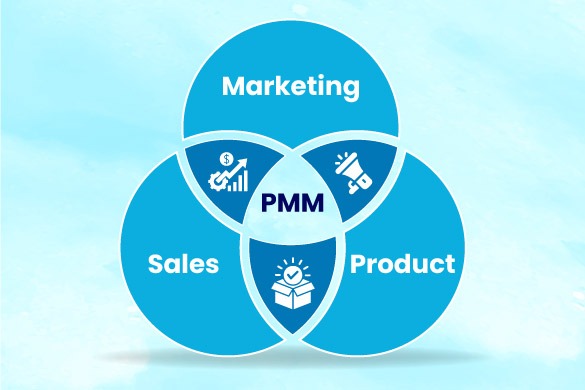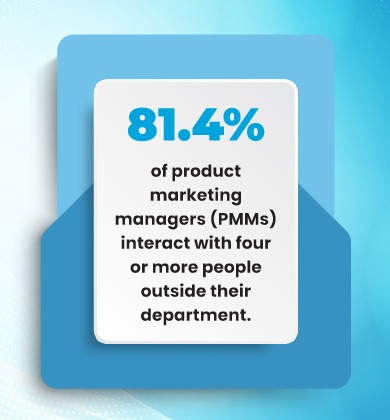Is your B2B product marketing strategy truly effective? In today’s crowded marketplace, having a great product is no longer sufficient. With numerous options vying for attention, the real challenge lies in clearly communicating your product’s unique value proposition and distinguishing it from the competition. Even the most innovative offerings can fade into obscurity without a strong marketing strategy. However, effective product marketing B2B can unlock your product’s full potential. By understanding your customers, crafting compelling messages, and executing a strategic go-to-market plan, you can break through the noise, engage your audience, and drive product success. This comprehensive guide will provide you with the insights and tools necessary to elevate your product marketing efforts.
What is Product Marketing?
Product marketing is essential for successfully launching and sustaining products in the market. Product marketing managers (PMMs) serve as the voice of the customer, crafting compelling messaging that resonates with customer segments through online product marketing strategies. They play a pivotal role in the product lifecycle, orchestrating various marketing activities like email campaigns, webinars, and sales enablement. Their role involves understanding customer pain points, communicating how a product addresses these challenges, and highlighting what differentiates it in the market. The Product Marketing Framework outlines five fundamental phases: Discover, Strategize, Define, Get Set, and Grow. This framework guides marketers through gathering insights, developing strategies, identifying intended audiences, preparing teams for go-to-market (GTM) efforts, and implementing post-launch growth strategies.
Additionally, a SWOT analysis can be used for marketing and product development planning, helping identify strengths, weaknesses, opportunities, and threats that inform strategic decisions. Overall, marketing a product is a vital, multifaceted discipline that helps businesses align products with customer needs and drive sustainable growth.

What is the Role of Product Marketing?
Product marketing plays a vital role in the success of individual products, providing distinct advantages over broader marketing strategies. One key reason for its importance is the challenge of marketing a product when launching new products. Effective product marketing B2B focuses not only on creating viable products but also on deeply understanding customer needs and desires. Dedicated product marketers ensure that each product communicates the right story, encompassing both functionality and messaging. Their involvement throughout the product lifecycle enhances the likelihood of success. By supporting customer outreach, tracking feedback, and providing valuable insights, product marketers empower sales teams to promote the product effectively.
Furthermore, a marketing department concentrated solely on brand marketing may overlook critical features or fail to achieve the necessary product-market fit. In contrast, product marketer focuses on individual products, significantly increasing their chances of resonating with target customers. Finally, the narrative surrounding a product is as crucial as the product itself. Even the best solution can struggle if not communicated effectively. The product marketing process crafts compelling messaging that highlights features and generates ongoing demand, ultimately driving customer success and establishing a robust market presence.
How Does Product Marketing Collaborate With Other Departments?
Product Marketing Manager (PMM) is a highly collaborative, cross-functional role that works closely with various teams to drive product success. Here’s how PMMs engage with different departments:
Product team: PMMs work closely with the product team to ensure that marketing a product is effective and that the product is positioned well in the market. They collaborate on understanding customer needs, identifying key features, and developing a compelling product narrative. Product managers provide technical insights and keep PMMs updated on the product roadmap. PMMs often attend product meetings to align on goals, such as improving retention or customer satisfaction, and to discuss the product marketing plan.
Executive leadership: Leadership looks to PMMs for market research, competitive analysis, and product viability reports, including insights on buyer personas. PMMs often present strategic insights and research that inform business decisions. Whether exploring new markets or evaluating product performance, PMMs provide critical data, such as understanding buyer personas, that shape the company’s direction.
Marketing team: PMMs guide the marketing team by defining the messaging, positioning, and strategy for product launches. They collaborate with the Chief Marketing Officer (CMO) and marketing managers in meetings to ensure consistency across campaigns. PMMs lead the execution of launch plans, overseeing content creation, market strategy, and the development of marketing assets that align with the product marketing plan.

Sales team: In the product marketing role, PMMs train the sales team in marketing a product, focusing on product features, messaging, and market positioning. They provide sales collateral like one-pagers, presentations, and demos, ensuring sales reps can communicate product value effectively. This collaboration is two-way; sales teams offer insights from customer interactions, which PMMs use to refine product messaging and strategies.
Revenue Operations (RevOps): RevOps supplies PMMs with customer data and behavior insights that guide product strategy in marketing, product positioning, and decision-making. In turn, PMMs collaborate with RevOps to track new metrics related to product performance, competitor activity, and sales effectiveness, all of which are essential for driving product led growth marketing strategies.
What is the Product Life Cycle in Marketing?
The product life cycle (PLC) is a framework that describes the stages a product goes through from its introduction to its decline. Each stage of the product marketing mix, including understanding what is product in the marketing mix, requires specific strategies to ensure product success and longevity.
Introduction stage: In the introduction stage, the primary goal is to create product awareness and generate initial sales. Marketing strategies here focus on educating the market about the product’s unique selling proposition (USP) and building brand awareness. A well-defined product marketing plan often employs aggressive promotional tactics. Digital and traditional advertising product marketing B2B campaigns are crucial to capture attention and communicate the product’s value.
Growth stage: As the product gains traction, the focus shifts to market expansion and customer retention. Marketing strategies for the growth stage include enhancing the product based on feedback, targeting new market segments, and expanding distribution channels. A comprehensive product marketing plan becomes essential to differentiate the product from competitors, and businesses should invest in strengthening their brand image. Continued promotions and customer engagement strategies help maintain momentum and build customer loyalty, including tailored product marketing campaigns that resonate with new audiences.
Maturity stage: The maturity stage is characterized by saturated markets and intense competition. To sustain sales, businesses implement strategies like product diversification and competitive pricing. Targeted marketing campaigns become more personalized, addressing specific customer needs and preferences. A strategic product marketing plan that includes customer loyalty programs also plays a significant role in retaining existing customers and encouraging repeat purchases.
Decline stage: As sales decline, cost management and focused customer success strategies become key. In this product marketing role, businesses may reduce marketing efforts, streamline production, and phase out the product while shifting attention to new offerings. Targeting loyal customers and offering exclusive deals can help extend the product’s life cycle, emphasizing a refined product strategy for optimal results.
Essential Elements of Product Marketing
A robust product marketing strategy is built on several essential components that work together to ensure product success. Here’s a breakdown:
Market and Customer Research
This is the foundation of any product marketing strategy. It involves gaining a deep understanding of customer needs, preferences, and market trends. By leveraging product marketing tech tools, marketers gather crucial insights into customer pain points and buying behavior. Additionally, analyzing competitor offerings helps identify gaps and opportunities for differentiation, particularly in the context of integrated marketing campaigns.
Product Positioning and Messaging
Armed with market research, product marketer crafts a unique selling proposition (USP) that sets the product apart from competitors. The product strategy within the product marketing plan should communicate the product’s benefits and address customer needs. A brand narrative is developed alongside a messaging framework that resonates with the audience, ensuring consistency across channels. A well-crafted positioning statement is pivotal. Utilizing product marketing tools can enhance this process, facilitating effective communication and alignment within teams to support integrated marketing campaigns.
Go-to-Market Strategy and Execution
An effective go-to-market strategy is vital for a successful product launch. This includes defining pricing strategies, creating a content marketing plan, and developing a social media strategy. Cross-functional collaboration with teams is key, as is ensuring sales enablement through training and collateral that supports product messaging. Tactics like influencer marketing, webinars, and affiliate partnerships can be powerful tools to drive product awareness and adoption.
Product Marketing Analytics and Optimization

Finally, continuous measurement and optimization are crucial for long-term success in product adoption. Tracking key performance indicators (KPIs), conducting A/B testing, and analyzing data related to buyer personas help refine strategies. Regular performance reviews ensure that marketing efforts are efficient, targeted, and aligned with business objectives.
Developing a B2B Product Marketing Strategy
Creating an effective product marketing strategy involves several key steps that can help your business connect with the right audience and achieve market success.
Define Your Target Audience
Start by clearly defining your target audience within the product marketing funnel as part of your product strategy in marketing. Develop one or more user personas to represent your ideal buyers, detailing their demographics, job roles, pain points, and goals. Understanding who your customers are and what they need will help you tailor your marketing efforts effectively.
Position Your Product Successfully
Product positioning is critical for differentiating your offering in the market. It involves identifying your product’s niche and ensuring that potential customers see its value. A well-positioned product communicates how it meets the needs of its prospective customers, creating a favorable perception that sets the stage for a successful launch.
Decide on Key Messaging
Craft a key message that encapsulates the value your product offers within your product marketing mix. Victoria Kouyoumjian, a GTM leader at Intel suggests that successful product marketing has a solid messaging and positioning framework at its foundation. This message should address the primary pain points of your target audience clearly and memorably. A strong key message will help reinforce your brand identity and make it easier for customers to understand why they should choose your product.
Define Pricing and Sales Strategies
Your pricing strategy can significantly impact your product’s market success. Decide whether you will use a sales-led approach, which relies on a traditional sales team, or a product-led strategy, where the product itself drives growth through mechanisms like free trials or demos. Your choice should align with your audience segments and the unique value proposition of your product.
Choose Relevant Marketing Channels
Identify the best channels to reach your audience based on where they spend their time. This could include social media, content marketing, email marketing, or industry events. Ensure that your marketing channels align with your overall go-to-market strategy and are capable of engaging different segments of your audience as they move through the buyer’s journey.
Set Specific Goals
Establish SMART (Specific, Measurable, Achievable, Relevant, Time-bound) goals to guide your marketing efforts within your product marketing frameworks. These goals will help align your team and provide clear benchmarks for measuring success. Regularly assess your progress to ensure that your strategy remains effective and responsive to market changes.
Analyze and Optimize
Finally, continuously analyze the performance of your marketing strategy. Look at key product marketing metrics to identify what works and what doesn’t, making adjustments as necessary. This iterative process allows you to optimize your tactics and stay aligned with your business objectives. By applying these product marketing frameworks, you can enhance your overall strategy and ensure a more effective approach to achieving your goals.
Challenges and Solutions in B2B Product Marketing
Challenge 1: Lead Generation and Traffic Building
Generating leads and driving traffic is fundamental to product marketing, but it’s often challenging to cut through the noise. One solution is leveraging AI for personalized content, which boosts engagement by addressing focus groups’ needs directly. Account-based marketing (ABM) allows for hyper-targeted campaigns, while partnerships for cross-promotion expand reach. HubSpot’s success in inbound marketing exemplifies how valuable, audience-specific content can generate substantial leads.
Challenge 2: Content Marketing and SEO
B2B content marketing relies on a strong synergy with SEO. Starting with comprehensive keyword research ensures that content answers customer queries. Advanced techniques like voice search optimization and semantic SEO further enhance visibility. By integrating video content and staying on top of emerging SEO trends like AI-driven algorithms and mobile-first indexing, marketers can drive traffic and engagement. Adobe taps into its extensive network of content creators, using user-generated content to fill its Instagram feed with inspiring work crafted with its digital tools.
Challenge 3: Targeting and Positioning
Effective targeting and positioning start with building accurate buyer personas. Data analysis helps identify customer pain points, while competitive analysis reveals market gaps. AI tools can dynamically refine these efforts in real time. Social media insights and big data analytics also provide vital information for ongoing optimization, ensuring that your product’s unique value proposition resonates with your audience. Dropbox, the digital content sharing and hosting platform, leverages its LinkedIn brand channel to share not only product and company updates but also to showcase its employees.
Challenge 4: Customer Retention and Loyalty
Retaining B2B customers requires a dedicated focus on fostering long-term relationships. Customized loyalty programs, predictive analytics, and thriving customer communities offer innovative ways to cultivate and enhance loyalty among clients. Integrating these strategies with consistent communication, personalized outreach, and robust feedback loops significantly enhances customer retention, ensuring they evolve into passionate brand advocates who actively promote the business to others.
Challenge 5: Measuring Success and ROI
Accurate ROI measurement is crucial for understanding campaign effectiveness. Advanced analytics tools and seamless CRM integration help track meaningful metrics, such as lead conversion rates, customer acquisition costs, and customer lifetime value. By effectively interpreting these insights, marketers can pivot strategies for continuous improvement, optimizing campaigns for sustainable long-term growth while ensuring alignment with overall business objectives.

Best Practices for Effective B2B Product Marketing
Effective product marketing mix requires a strategic approach that encompasses various channels and tactics. Here are six best practices to ensure successful outcomes:
Utilize content marketing: Establishing your brand as a thought leader is crucial. Develop diverse content formats such as blogs, white papers, and infographics tailored to your consumer’s interests. This not only enhances your credibility but also improves customer engagement. Regularly assess the performance of your content to refine your strategy and adapt to audience preferences. Additionally, consider exploring what is the least common product marketing technique. This can set you apart from competitors.
Leverage email marketing: Email remains a powerful tool for nurturing leads. Personalize your communication and ensure that every message offers value to the recipient. Avoid being overly promotional or spammy, as this can lead to unsubscribes. Use email as a platform to share insights, product updates, and educational content, fostering a relationship that encourages prospects to explore your offerings further.
Focus on product marketing: Directly showcase your product through well-crafted marketing materials. Highlight unique features and benefits with engaging visuals and clear messaging. Consider hosting webinars or creating case studies to provide potential customers with real-life applications of your product. Ensure that your materials are not only informative but also visually appealing to capture attention.
Implement paid search/PPC campaigns: Targeting specific keywords through paid search allows you to reach potential customers actively searching for solutions like yours. Utilize sequential advertising to guide prospects through their buyer journey effectively. Experiment with various ad formats and platforms to find the most effective strategy for your audience and budget.
Invest in search engine optimization (SEO): A strong SEO strategy increases your website’s visibility in search results, driving organic traffic. Focus on optimizing your content with relevant keywords, improving site speed, and enhancing user experience. Regularly analyze top-performing pages in your industry to identify best practices and areas for improvement.
Engage on social media: Use social media platforms to foster community interaction and gather feedback. Determine which platforms best suit your target demographic and develop a consistent brand voice that resonates with your audience. Prioritize community management by addressing customer inquiries and concerns promptly, building trust and loyalty over time.
Case Studies: How Top Brands Excel in Product Marketing
Here are product marketing strategy examples of effective product marketing from various companies:
Slack: Slack has positioned its communication platform as an essential tool for improving team collaboration and productivity, exemplifying an essential technique for effective product marketing strategy. Their messaging addresses the pain points of their audience, highlighting how the platform facilitates better communication. Slack showcases practical benefits, emphasizing features like integration with other tools and ease of use, making it clear why businesses should adopt their solution.
Adobe: Adobe’s Document Cloud demonstrates how to market a product suite effectively through clear messaging focused on streamlining workflows. Using a problem-solution approach, Adobe illustrates the value of its product in enhancing efficiency. Compelling visuals and accessible language set their marketing apart, making it easy for businesses to grasp the benefits, serving as another example of a marketing plan for a new product.
HubSpot: Renowned for its inbound marketing model, HubSpot successfully showcases how its tools support business growth through content marketing and SEO. By providing compelling product marketing campaign examples,HubSpot positions itself as a thought leader, building trust and credibility. Their marketing strategy emphasizes the effectiveness of their solutions while empowering customers with knowledge.
Salesforce: Salesforce markets its cloud-based CRM solution by focusing on enhancing customer relationships and sales performance through effective product marketing techniques. They utilize customer testimonials and case studies to illustrate the value of their products. Salesforce fosters strong connections with potential customers by creating a seamless and personalized experience across various touchpoints.
Zoom: Zoom has successfully positioned itself as a reliable and user-friendly remote communication tool. Their messaging is clear, highlighting the simplicity and functionality of their product. As an example of a marketing plan for a new product,Zoom’s responsiveness to customer needs and its focus on providing a seamless user experience make its product marketing stand out in a competitive landscape.
In conclusion, effective product marketing B2B is essential for navigating the complexities of today’s competitive landscape, especially for those looking to understand how to get into product marketing. By thoroughly understanding customer needs and employing a structured approach—from defining target audiences to crafting compelling messaging—businesses can position their products for success. Continuous collaboration across departments, strategic use of analytics, and a focus on both acquisition and retention are vital to driving engagement and loyalty. As markets evolve, staying agile and responsive will empower product marketers to optimize their strategies and foster deeper connections with their audiences. Ultimately, mastering product marketing not only enhances individual product success but also contributes to sustained business growth in the long run.




